初一上册英语备课教案
- 格式:docx
- 大小:31.25 KB
- 文档页数:16

初一上册英语教案初一上册英语教案1教学目标:1、语言目标(Language skills)巩固和强化上节课的知识: can I have ? Yes, you can./ No, you can't.能在图片的提示下听懂、认读、说出新单词:puter game、jipsaw puzzel、careful、fix,并懂得其意。
学会表达某人拥有某物的功能句型“I’ve got 。
He’s got。
She’s got。
It’s got。
”来进行交流。
2、技能目标(Objectives of skills)学会运用have got 表述拥有某物3、情感目标(Objectives of emotion and attitude)让学生通过自由对话交流自己拥有的东西,达到让其开口说英语的目的,从而激发他们学习英语的兴趣及运用英语交流的热情。
重点难点:能正确拼读新单词:puter game、jipsaw puzzel、careful、fix; 理解本课句型:I have got。
并能够运用此句型和别人交流自己拥有的东西。
教学过程:Step1、Warming up:Greeting. T: Hello, boys and girls!S: Hello, teacher!T: How are you, today?S: Fine, thank you.T:What’s the weather like today?S:It’s sunny day.设计意图:以简单轻松的问候进入一个比较愉悦的课堂教学。
Step 2、Lead-in:老师指自己的物品,如课本、衣服等问。
T:what’s this ? S:This is a book;This is a coat.T:This is my book. I’ve got a book. This is my coat. I’ve got a coat. (板书并做动作让学生理解意思I’vegot )让学生运用I’ve got——像老师一样描述自己拥有的东西。
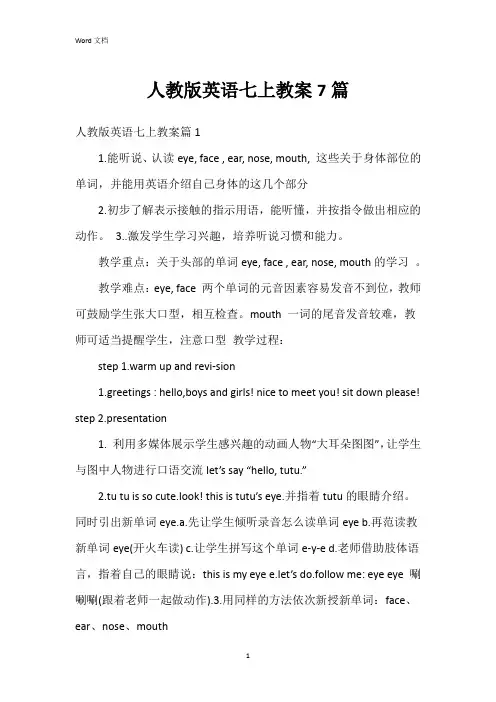
人教版英语七上教案7篇人教版英语七上教案篇11.能听说、认读eye, face , ear, nose, mouth, 这些关于身体部位的单词,并能用英语介绍自己身体的这几个部分2.初步了解表示接触的指示用语,能听懂,并按指令做出相应的动作。
3..激发学生学习兴趣,培养听说习惯和能力。
教学重点:关于头部的单词eye, face , ear, nose, mouth的学习。
教学难点:eye, face 两个单词的元音因素容易发音不到位,教师可鼓励学生张大口型,相互检查。
mouth 一词的尾音发音较难,教师可适当提醒学生,注意口型教学过程:step 1.warm up and revi-sion1.greetings : hello,boys and girls! nice to meet you! sit down please! step2.presentation1. 利用多媒体展示学生感兴趣的动画人物“大耳朵图图”,让学生与图中人物进行口语交流let’s say “hello, tutu.”2.tu tu is so cute.look! this is tutu’s eye.并指着tutu的眼睛介绍。
同时引出新单词eye.a.先让学生倾听录音怎么读单词eye b.再范读教新单词eye(开火车读) c.让学生拼写这个单词e-y-e d.老师借助肢体语言,指着自己的眼睛说:this is my eye e.let’s do.follow me: eye eye 唰唰唰(跟着老师一起做动作).3.用同样的方法依次新授新单词:face、ear、nose、mouth4.powerpoint制作:打开幻灯片后每点击一身体部位就会出现相应的单词。
(注mouth一词的尾音发音较难,适当提醒学生,注意口型。
)5.认读face、ear、eye、nose、mouth的单词卡片和图片。
step3:practice1.let’s do: eye eye 唰唰唰ear ear 呼呼呼nose nose 闻闻闻mouth mouth 巴巴巴face face 拍拍拍2.i say you do.(老师说,学生快速做相应的动作,然后找一位学生出来做出动作。

初一上册英语教案(经典版)编制人:__________________审核人:__________________审批人:__________________编制单位:__________________编制时间:____年____月____日序言下载提示:该文档是本店铺精心编制而成的,希望大家下载后,能够帮助大家解决实际问题。
文档下载后可定制修改,请根据实际需要进行调整和使用,谢谢!并且,本店铺为大家提供各种类型的经典范文,如工作总结、工作计划、演讲致辞、规章制度、合同协议、条据文书、励志名言、好词好句、教学资料、其他范文等等,想了解不同范文格式和写法,敬请关注!Download tips: This document is carefully compiled by this editor. I hope that after you download it, it can help you solve practical problems. The document can be customized and modified after downloading, please adjust and use it according to actual needs, thank you!Moreover, our store provides various types of classic sample essays, such as work summaries, work plans, speeches, rules and regulations, contract agreements, policy documents, inspirational quotes, good words and sentences, teaching materials, other sample essays, and more. If you want to learn about different sample formats and writing methods, please stay tuned!初一上册英语教案初一上册英语教案【5篇】教案为教师提供了指导和支持,明确了教学的目标和方法。
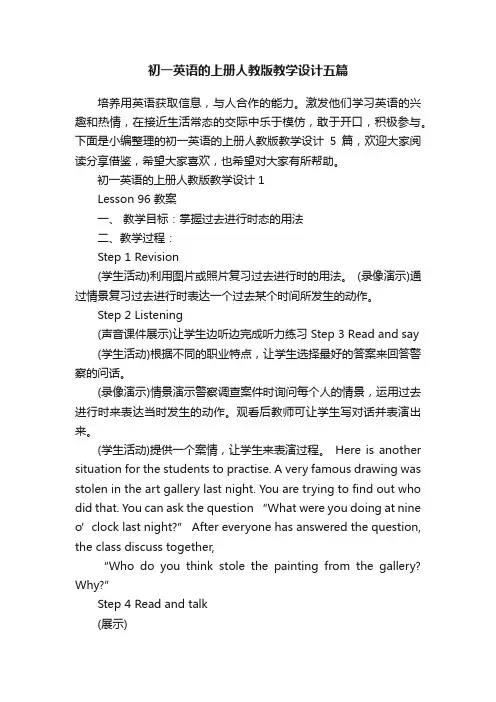
初一英语的上册人教版教学设计五篇培养用英语获取信息,与人合作的能力。
激发他们学习英语的兴趣和热情,在接近生活常态的交际中乐于模仿,敢于开口,积极参与。
下面是小编整理的初一英语的上册人教版教学设计5篇,欢迎大家阅读分享借鉴,希望大家喜欢,也希望对大家有所帮助。
初一英语的上册人教版教学设计1Lesson 96 教案一、教学目标:掌握过去进行时态的用法二、教学过程:Step 1 Revision(学生活动)利用图片或照片复习过去进行时的用法。
(录像演示)通过情景复习过去进行时表达一个过去某个时间所发生的动作。
Step 2 Listening(声音课件展示)让学生边听边完成听力练习 Step 3 Read and say (学生活动)根据不同的职业特点,让学生选择最好的答案来回答警察的问话。
(录像演示)情景演示警察调查案件时询问每个人的情景,运用过去进行时来表达当时发生的动作。
观看后教师可让学生写对话并表演出来。
(学生活动)提供一个案情,让学生来表演过程。
Here is another situation for the students to practise. A very famous drawing was stolen in the art gallery last night. You are trying to find out who did that. You can ask the question “What were you doing at nine o’clock last night?” After everyo ne has answered the question, the class discuss together,“Who do you think stole the painting from the gallery? Why?”Step 4 Read and talk(展示)Read the table about what David was doing at different times yesterday, then ask and answer in pairs.(录像演示)情景演示询问过去某个时间点正在进行的动作,看后让学生进行模仿练习。
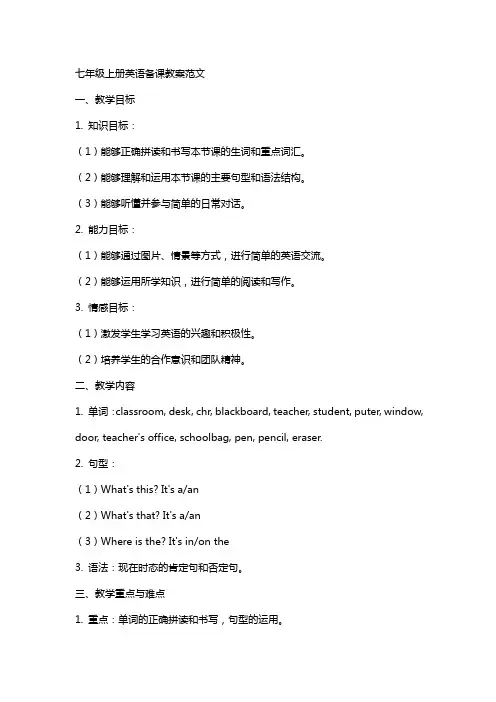
七年级上册英语备课教案范文一、教学目标1. 知识目标:(1)能够正确拼读和书写本节课的生词和重点词汇。
(2)能够理解和运用本节课的主要句型和语法结构。
(3)能够听懂并参与简单的日常对话。
2. 能力目标:(1)能够通过图片、情景等方式,进行简单的英语交流。
(2)能够运用所学知识,进行简单的阅读和写作。
3. 情感目标:(1)激发学生学习英语的兴趣和积极性。
(2)培养学生的合作意识和团队精神。
二、教学内容1. 单词:classroom, desk, chr, blackboard, teacher, student, puter, window, door, teacher's office, schoolbag, pen, pencil, eraser.2. 句型:(1)What's this? It's a/an(2)What's that? It's a/an(3)Where is the? It's in/on the3. 语法:现在时态的肯定句和否定句。
三、教学重点与难点1. 重点:单词的正确拼读和书写,句型的运用。
2. 难点:现在时态的肯定句和否定句的构成和运用。
四、教学方法1. 情景教学法:通过设置真实的情景,让学生在实际语境中学习和运用英语。
2. 交际法:通过小组合作、角色扮演等方式,让学生积极参与英语交流。
3. 任务型教学法:通过完成具体任务,让学生在实践中学习和运用英语。
五、教学步骤1. 热身(5分钟)(1)和学生打招呼,询问他们昨天的活动。
(2)引导学生用英语进行简单的自我介绍。
2. 导入(10分钟)(1)向学生介绍本节课的主题:学校环境。
(2)展示图片,引导学生用英语描述图片中的物品。
3. 新课(20分钟)(1)教授生词和词汇,让学生跟读并模仿。
(2)讲解句型和语法,让学生进行实际操作练习。
4. 练习(15分钟)(1)分组进行角色扮演,让学生运用所学知识进行对话。
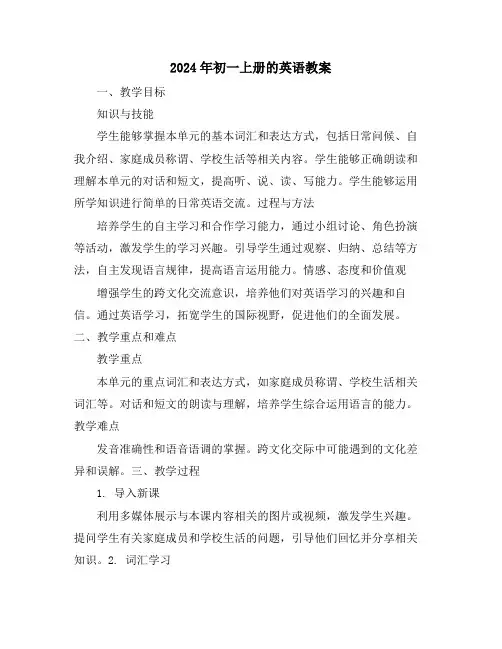
2024年初一上册的英语教案一、教学目标知识与技能学生能够掌握本单元的基本词汇和表达方式,包括日常问候、自我介绍、家庭成员称谓、学校生活等相关内容。
学生能够正确朗读和理解本单元的对话和短文,提高听、说、读、写能力。
学生能够运用所学知识进行简单的日常英语交流。
过程与方法培养学生的自主学习和合作学习能力,通过小组讨论、角色扮演等活动,激发学生的学习兴趣。
引导学生通过观察、归纳、总结等方法,自主发现语言规律,提高语言运用能力。
情感、态度和价值观增强学生的跨文化交流意识,培养他们对英语学习的兴趣和自信。
通过英语学习,拓宽学生的国际视野,促进他们的全面发展。
二、教学重点和难点教学重点本单元的重点词汇和表达方式,如家庭成员称谓、学校生活相关词汇等。
对话和短文的朗读与理解,培养学生综合运用语言的能力。
教学难点发音准确性和语音语调的掌握。
跨文化交际中可能遇到的文化差异和误解。
三、教学过程1. 导入新课利用多媒体展示与本课内容相关的图片或视频,激发学生兴趣。
提问学生有关家庭成员和学校生活的问题,引导他们回忆并分享相关知识。
2. 词汇学习展示本单元的重点词汇,并带领学生进行朗读。
通过上下文语境,解释词汇的含义和用法。
设计小游戏或竞赛,让学生在轻松愉快的氛围中记忆词汇。
3. 对话练习分角色朗读对话,注意语音语调的准确性。
小组讨论,模拟对话场景,进行角色扮演练习。
教师提供情景提示,引导学生自由发挥,创造性地进行对话练习。
4. 短文阅读教师首先进行短文朗读示范,注意语音语调和节奏。
学生跟读短文,并尝试理解短文大意。
分组讨论短文内容,回答教师提出的问题,加深对短文的理解。
5. 文化体验介绍与本课内容相关的文化背景知识,帮助学生了解不同国家的文化习俗。
设计跨文化交流活动,如模拟国际学校生活,让学生在体验中感受文化差异。
邀请英语母语人士进行互动,让学生直接接触和了解地道的英语表达和文化。
6. 课堂小结总结本堂课所学的重点词汇和表达方式。
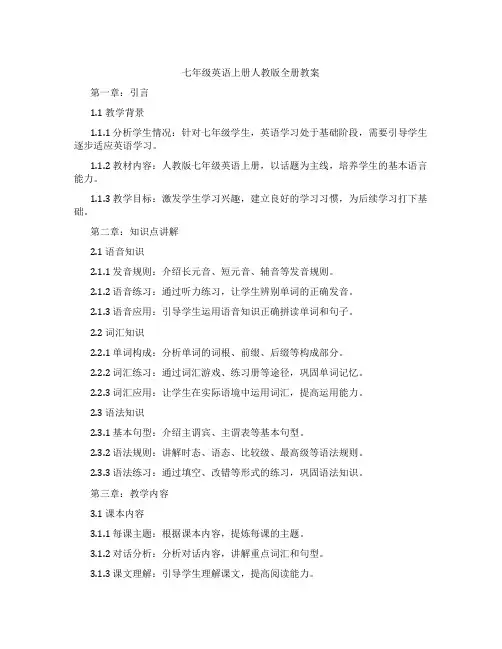
七年级英语上册人教版全册教案第一章:引言1.1 教学背景1.1.1 分析学生情况:针对七年级学生,英语学习处于基础阶段,需要引导学生逐步适应英语学习。
1.1.2 教材内容:人教版七年级英语上册,以话题为主线,培养学生的基本语言能力。
1.1.3 教学目标:激发学生学习兴趣,建立良好的学习习惯,为后续学习打下基础。
第二章:知识点讲解2.1 语音知识2.1.1 发音规则:介绍长元音、短元音、辅音等发音规则。
2.1.2 语音练习:通过听力练习,让学生辨别单词的正确发音。
2.1.3 语音应用:引导学生运用语音知识正确拼读单词和句子。
2.2 词汇知识2.2.1 单词构成:分析单词的词根、前缀、后缀等构成部分。
2.2.2 词汇练习:通过词汇游戏、练习册等途径,巩固单词记忆。
2.2.3 词汇应用:让学生在实际语境中运用词汇,提高运用能力。
2.3 语法知识2.3.1 基本句型:介绍主谓宾、主谓表等基本句型。
2.3.2 语法规则:讲解时态、语态、比较级、最高级等语法规则。
2.3.3 语法练习:通过填空、改错等形式的练习,巩固语法知识。
第三章:教学内容3.1 课本内容3.1.1 每课主题:根据课本内容,提炼每课的主题。
3.1.2 对话分析:分析对话内容,讲解重点词汇和句型。
3.1.3 课文理解:引导学生理解课文,提高阅读能力。
3.2 拓展内容3.2.1 相关话题:针对课本内容,拓展相关话题。
3.2.2 听力练习:选择合适的听力材料,提高学生听力水平。
3.2.3 口语表达:组织口语交流活动,提高学生口语表达能力。
第四章:教学目标4.1 知识目标4.1.1 掌握基本的语音、词汇和语法知识。
4.1.2 能够听懂、说出一日常用语。
4.1.3 理解课本内容,具备一定的阅读和写作能力。
4.2 能力目标4.2.1 提高学生的听、说、读、写四项基本技能。
4.2.2 培养学生的语言运用能力和团队协作能力。
4.2.3 培养学生的跨文化交际意识。
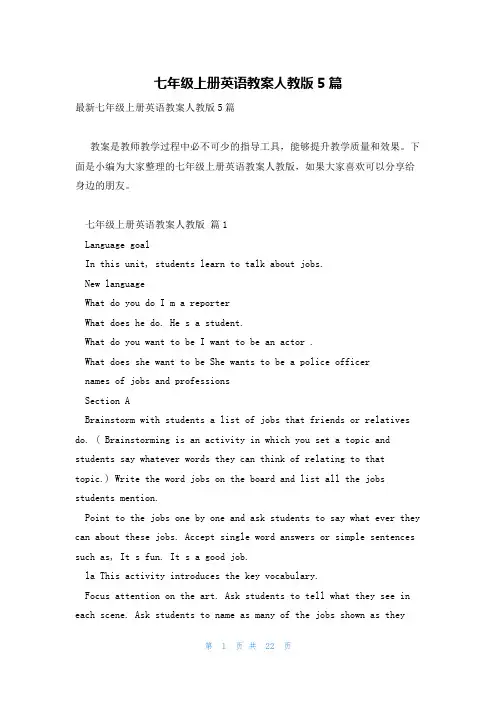
七年级上册英语教案人教版5篇最新七年级上册英语教案人教版5篇教案是教师教学过程中必不可少的指导工具,能够提升教学质量和效果。
下面是小编为大家整理的七年级上册英语教案人教版,如果大家喜欢可以分享给身边的朋友。
七年级上册英语教案人教版篇1Language goalIn this unit, students learn to talk about jobs.New languageWhat do you do I m a reporterWhat does he do. He s a student.What do you want to be I want to be an actor .What does she want to be She wants to be a police officernames of jobs and professionsSection ABrainstorm with students a list of jobs that friends or relatives do. ( Brainstorming is an activity in which you set a topic and students say whatever words they can think of relating to that topic.) Write the word jobs on the board and list all the jobs students mention.Point to the jobs one by one and ask students to say what ever they can about these jobs. Accept single word answers or simple sentences such as, It s fun. It s a good job.la This activity introduces the key vocabulary.Focus attention on the art. Ask students to tell what they see in each scene. Ask students to name as many of the jobs shown as theycan. Then point to a scene, name the job, and ask students to repeat. Point to the numbered list of words. Say each one and ask students to repeat.Then ask students to match each word wllfa one of the scenes. Say, Write the letter of each scene next to one of the ivords. Point tothe sample answer.1 b This activity gives students practice in understanding thetarget language in spoken conversation.Point to the different people shown in the picture.Ask various students to tell what they do as you point to each one,Say, Now you will hear three conversations. The conversations are about three of the people in this picture.Play the recording the first time. Students only listen.Play the recording a second time. This time ask students to write a number 1 next to the person being talked about in conversation 1. Have students put a 2 and 3 next to the people being talked about in conversations 2 and 3.Correct the answers.1 c This activity provides guided oral practice using the target language-Ask a student to read the example conversation with you. Hold upthe book and point to the doctor in the picture.Say, Now work with your partner. Make your own conversations about the picture. You can use sentences like the ones in activity 1b.Say a dialogue with a student. Point to a picture of one of the people. Guide the student to answer using one of the words inactivity 1a.As students work in pairs, move around the room monitoring theirwork. Oner language or pronunciation support as needed.2a This activity gives students practice in understanding thetarget language in spoken conversation.Ask students to look at the three pictures. Ask different students to tell you what they sec in each picture. What are the people doing What jobs do they havePlay the recording the first time. Students only listen.Say, You will hear conversations about the people in these pictures.Play the recording a second time. Say, Write the number of each conversation below the picture of the person being talked about.Correct the answers.2b This activity gives students practice in understanding thetarget language in spoken conversation.Point to the three headings in the chart and read the headings to the class. Ask students, What does wants to be mean (It is not the Job the person lias now. It is the job the person wants in the future.)Play the recording the first time. Students only listen.Say, You wiU hear about the people in these pictures. You will hear the job they haw now and the job they want in the future.Play the recording a second time. This time ask students to fill in the blanks with the jobs the people have now and the ones they wantin the future. Point out the sample2c This activity provides guided oral practice using the target language.Point out the pictures in activity 2a. Ask who each person is. (They are Susan s brother. Anna s mother, and Tony s father.)Say, Now work with your partner. Ask and answer questions about thepictures. Ask, What does he or she do Then ask, What does he or she want to beSay a dialogue with a student. Point to Anna s mother and then to the example in the speech balloons. Practice the dialogue with a student.As students work In pairs, move around the room monitoring their work. Offer language support as needed.3a This activity introduces the names for the places where people work, and gives reading practice using the target language.Call attention to the pictures. Ask students to read the name for each place. As they name each place, write the word on the board and-ask the class to repeat it.Point out the list of jobs with the numbers next to each. Then call attention to the people in the pictures and the speech bubbles. Point out the sample answer and have a student read out the speech bubble. Ask students to work alone. Say, Write the number of each job in the square next to each workplace.Check the answers.3b This activity provides guided oral practice using the target language.Point out the pictures in activity 3a. Ask students to name the workplace shown In each picture.Then point out the conversation in the speech bubbles. Ask two students to read It to the class.Say, Wow work with a partner. First practice the conversation in the picture. Then make new conversations. Use jobs and places from activity 3a.Say a dialogue with a student. Point to the word waiter in activity3a and then to the picture of the restaurant. Ask a student. Where does he work Guide the student to answer using the correct place: He works in a restaurant.Then ask. What does he do and guide the student to answer, He s a waiter.As students work in pairs, move around the room monitoring their work. Offer language support as needed.4 This activity provides listening and speaking practice using the target language.Call attention to the pictures in the book showing how to play the game. Say, You will draw a picture of someone working. Other students will ask questions about the kind of job you are drawing. After two questions someone can try to guess the job.Demonstrate by drawing a picture on the board of a stick figure reporter. Add details (microphone, notebook,etc.) until students guess what job it is.Ask a student to go to the board. Say, Draw a picture of a person working. If necessary, help the student add details that show the job the person is doing. He or she can add a bank interior to show that the person is a bank clerk. A student could also use an eye chart on the wall to show that the place is a doctor s office and the personis a doctor.Ask two different students to ask questions about the Job, and then ask a third student to guess what job it is.Play the game using drawings by several different students.Alternative: If you do not want students to move from their seats, then you can ask them to do this activity sitting down in groups of four. They will need pieces of paper on which to draw their pictures. They will also need pencils.Section BNew languageWords that describe jobs, such as exciting, dangerous,boring, difficult, busy, funAdditional materials to bring to class:help wanted ads from an English-language newspaper1 a This activity introduces the key vocabulary.Focus attention on the six pictures. Ask, What job does the person have Where does the person ivnrkPoint out the numbered list of words. Say each one and ask students to repeat. Then use simple explanations and short sample sentences to help students understand what each word means. For example, Exciting means very interesting and very fast-moving. A police officer has an exciting job. The job is always changing. Something is always happening. For dangerous you might say, Dangerous means not safe. You might be hurt or killed in a dangerous job.Then ask students to match each word with one of the pictures. Say, Write the letter of each picture next to one of the words. Point out the sample answer.Check the answers.1 b This activity provides guided oral practice using the target language.Call attention to the picture In this activity and ask a student to read the statement to the class. Then point to the picture of the police officer and say. It s an exciting job. Ask the class to repeat. Then say, What else can you say about being a police officer Someone may answer, It s a dangerous job. Ask the class to repeat each correct answer.Then ask students to work in pairs. Suggest that they each point to the pictures of the workers and make statements about them. As students practice, move around the classroom monitoring their work.1 c This activity provides an opportunity for oral practice.Say, Name some of the jobs from this unit. Write this list of jobs on the board. Say, Can you name some other jobs Add any new jobs to the list.Ask some students to make statements about Jobs on the list using the words in activity la. You may wish to write some of the sentences on the board so that students can copy the sentences into their notebooks.2a This activity provides listening and writing practice with the target language.Call attention to the two headings and ask a student to read die headings to the class.Point out the blank lines where students will write the name of a job (under the words wants to be).Play Ihe recording the first time. Students only listen.Say, Now I will play the tape again. This time write the name of a job under the words wants to be.2b This activity provides listening and writing practice with the target language,Call attention to the second heading and ask a student to read it to the class. Say, This time you will unite why each person wants the job.Play the recording again. Students only listen.Then say, Now I will play the tape again. This time write the reason the person wants the job under the word WhyPlay the recording. Students write their answers.Check the answers.2C This activity provides open-ended oral practice using the target language.Say, What do you want to be What words describe each job Help the class make up a list of jobs they might like to do. As students suggest possible jobs, ask the class to suggest words to describe them. Use a bilingual dictionary, if necessary, to find the names of jobs and words to describe each one.Then ask students to work in small groups. They tell each otherwhat they want to do and why. Encourage students to use dictionariesif necessary. Move from group to group offering assistance as needed. Ask individual students to tell the class about what they want tobe and why.3a This activity provides reading and writing practice using the target language.Call attention to the three newspaper ads and read these ads to the class. Say blank each time you come to a blank line.Then read each ad again separately, pausing to allow students toask questions about anything they don t understand. For example, in the first ad, students may not know that working late means workingat night. To work hard means to use a lot of energy to do the job.Ask students to fill In (he blanks in the ads using the words actor, reporter, and waiter.Check the answers.3b This activity provides reading and writing practice using the target language.Call attention to the newspaper ad and ask a student to read it,saying blank for each blank line.Ask students to fill in the blanks using words from This section. Say,Look at the pictures next to each blank line. The pictures will help you guess the correct word.Suggest that they look at the names of jobs and the words that describe jobs in the first part of Section B.Check the answers,3c This activity provides writing practice using the targetlanguage.Point out the blank strip of newspaper where students can write their own ads.Ask one or two students, What are you going to write about Repeat each of the students sentences and ask the class to repeat the sentences after you. For example: Do ^OM want an interesting but dangerous job Do you want to meet new people We need a police officer.Call the Smithtown Police Station at 555-2323.Ask students to read their ads to a partner. Ask the pairs to correct each other s work.4 This activity provides guided oral practice using thetarget language.Ask two students to read the conversation in the speech bubbles. Answer any questions students may have about it.Then say, New please work in groups. Ask efuestions to find out what jobs each person wrote about. You can use sentences like the ones we just read.As students ask questions, move from group to group. Rephrase any incomplete or incorrect questions.Also rephrase any inaccurate answers.七年级上册英语教案人教版篇2Unit 3 Language in use课型 Revision and application教材分析 Unit 3 对“自我介绍和获取信息”的功能句式进行综合训练:谈论自己或朋友的情况(活动1);根据提示完成介绍图片中人物情况的句子;填表、匹配复习表示国家、民族及人物活动的词汇。
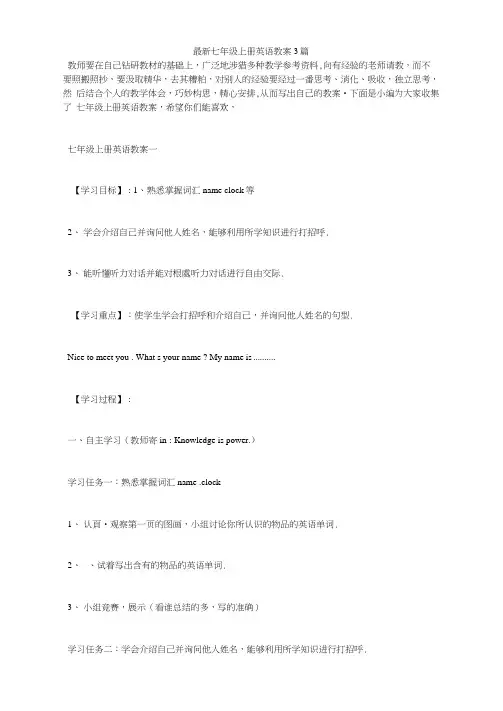
最新七年级上册英语教案3篇教师要在自己钻研教材的基础上,广泛地涉猎多种教学参考资料,向有经验的老师请教,而不要照搬照抄,要汲取精华,去其糟粕,对别人的经验要经过一番思考、消化、吸收,独立思考,然后结合个人的教学体会,巧妙构思,精心安排,从而写出自己的教案•下面是小编为大家收集了七年级上册英语教案,希望你们能喜欢,七年级上册英语教案一【学习目标】:1、熟悉掌握词汇name clock等2、学会介绍自己并询问他人姓名,能够利用所学知识进行打招呼.3、能听懂听力对话并能对根處听力对话进行自由交际.【学习重点】:使学生学会打招呼和介绍自己,并询问他人姓名的句型.Nice to meet you . What s your name ? My name is ..........【学习过程】:一、自主学习(教师寄in:Knowledge is power.)学习任务一:熟悉掌握词汇name .clock1、认頁•观察第一页的图画,小组讨论你所认识的物品的英语单词.2、、试着写出含有的物品的英语单词.3、小组竞赛,展示(看谁总结的多,写的准确)学习任务二:学会介绍自己并询问他人姓名,能够利用所学知识进行打招呼.1、教师自我介绍,引导学生介绍自己.A: Hello ,1 am Gina ・ What s your name ?B: My name is Alan ・2、小组竞赛,两人一组,询问他人姓名,介绍自己.3,、分角色朗读1A对话.学习任务三:能听懂听力对话并能对根据听力对话进行自由交际.1、、听录音,给1B的对话编号.2、根据听力对话进行自由交际.3、小组竞赛,展示对话交际.二、合作共建(教师寄语:Many hands make light work.)小组讨论我们所学的英语名字和汉语名字的区别,如何用英语拼写你的名字?三、系统总结(教师寄语:No man can do two things at once.)1,、归纳你所学到的问候语.2、自己编写一个打招呼并询问姓需的小对话.四、诊断评价(-)单项选择.1 ・____ your name ? My name is Gina ・A. WhatB. What sC. WhoD. which2.Good morning , Miss Wang ! ______________ !A. HelloB.HiC. Nice to meet youD. Good morning3.1 _______ Sally, What ______ your name ?A. am .isB. is 、amC. is , isD.am. am4. _____ name is Li lei ・A. IB. I amC. MyD. you5. _____ . What s your name ?John Green ・A. HiB. OkC. sorryD. Excuse me(二)写出下列单词的完全形式,并写出汉语意思.I m ____________________ what s ____________________ name s ______________________(三)写出下列单词.时钟________ 我的 _________ 你的____________ 名字________ 遇见(四)尝试翻译下列句子.1.见到你很高兴. ________________________________ .2.___________________________________________ 我叫王小雨. .3.你叫什么名字?____________________________________(五)根据情景补全对话.A: Good afternoon !B: _____________________ !A; I _____ Lucy . _________ y our name ?B: My ______ is Jim . Nice to ______ you !A: ________________________________ .五、【课后反思】(教师寄语:Never do things by halves)任务熟练掌握基本掌握没掌握第2课时Unit 1 My name s Gina.(总第2课时)Section A (la 2c)【学习目标】:1、熟练掌握本课6个单词.2、学会询问他人姓拿及介绍他人姓爼.3、能听懂有关谈论他人姓名的对话并进行自由交际. 【学习重点】:询问他人姓名及介绍他人姓需的句型.一、自主学习(教师寄in:Knowledge is power.)学习任务一:熟练读写本课6个单词.1 •个人自渎,记忆本课单词.2.小组互相检查单词读写情况.3.根据汉语写出下列英语单词并展示.学习任务二:运用句型:What s his / her name?His / Her name is ....进行自由交际.1 •小组合作,理解并熟读下列短语,并写出汉语意思. my nane () your name ()his name () her name ()2.个人理解下列对话,并且两人合作练习.A:Hello! What s your name?B:My name is Gina.A:Nice to meet you.B:Nice to meet you.too.A:What s her name?B:Her name is Jenny.3.小组合作,练习自己的对话.4.对抗组开展竞赛,展示自己的对话.学习任务三:听听力完成2a,2b.1•个人看图,理解四幅图画,思考图画中人是在谈论他人还是对方.2.听听力,给四幅图画编号.3.小组为单位,熟读2b中的名字.4•听听力,完成2b・二、合作共建(教师寄语:Many hands make light work.)讨论下而两句话如何用英语表达.1 •他叫Bob.2•她叫Jenny.三.系统总结(教师寄语:No man can do two things at once.)根据提示,完成下列问答.What s _______ name? ________ is ....四.诊断评价1、写出下列短语.(1)我的时钟(2)你的问题⑶他的名字(4)她的回答2、很据句意及首字母补全单词.(1) _______ is your name ?(2)Nice to m ______ you.(3)His a ________ is good.(4)L ____ ! His clock is beautiful(漂亮的)・三、选择1・ ______ . What s his name? His name is John Green・A. HiB. OhC. SorryD. OK2.She is a girl(女孩).What s ______ name?A. herB. sheC. she sD.his五、【课后反思】(教师寄语:Never do things by halves) 第3课时Unit 1 My name s Gina (总第3课时) Section A 3a 4【学习目标】:K熟悉掌握本右课的六个词汇.2、正确辨别英文名字的姓和名,以及和中文名字的差异.3、学会询问他人需和姓的句型.【学习重点】:掌握询问他人名和姓的句型.【学习过程】:一、自主学习(教师寄IS:Knowledge is power.)学习任务一:熟悉掌握词汇.1、个人自读,记忆本课单词.2、小组相互检查单词读和写的情况.3、、据汉语写出单词,小组竞赛并展示.学习任务二:能运用句型:Whal s your first name ?My first name is•…What s your last name?My last name is…进行交际.l.试读下列姓名,尝试总结归纳.Gina MillerFirst name : ________ Last name: ________完成3a •(让对抗号在黑板上展示)2、理解下列对话,两人合作练习.A: Hello! What s your name?B: My name is Jack Smith.A: What s your first name ?B: My first name is....A: What s your last name?B: My last name is...3、小组合作,练习自己的对话.4、对抗小组开展竞赛,展示自己的对话.(完成3b)二、合作共建(教师寄语:Many hands make light work.)学会了询问他人的需和姓的句型后,能否用his/her做替换练习.三、系统总结(教师寄语:No man can do two things at once.)1、总结你所知道的需和姓.2、自己编写一个询问他人姓和名的小对话.四、诊断评价(一)用所给词的适当形式填空.1 ・ Nice to meet _____ (your).2. ____ (she) name is Helen Black・3.His family name _____ (be) Mr Green.4.____ (be) you Mr Green・5.HL I ____ (be) Lily.(-)据汉语完成句子1.Brown 是他的姓氏.Brown is _______________ name.2.她的名是什么?____________________ name?3.你好,我是杰克.Hi. ________ J ack.4.我的钢笔是黑色的. _____ pen is ______ .5.他的名字是吉姆. _______________ Jim.(三)根据上下文完成对话.A: Hello!B: ________ !A: I m Gina, _______________ ?B: My name is Linda Brown.A: Is Linda your last name?B: No.Linda is my ___________ ・ And Brown is _________ ・A: Nice to meet you.B: _____________________ ・七年级上册英语教案二UnitlMyname sGina.SectionA一、教师寄语:Athousand-lijoumeyisstartedbytakingthefirststep.千里之行,始于足下.二.学习目标:Knowledgeaims(知识目标)Keywords:mynamcniccmcctyouwhat shisherKeyphrases:mynanie,firstnameJastnanie,answerthequestion ・Kcysentences:What syourname?What shisname?What shername?及回答.Abilityaims(能力目标)1.掌握简单的问候语,并能自我介绍,初步培养用英语进行交际的能力.2.掌握听的技能,在听的过程中准确获取数字信息.Moralaims(情感目标)礼貌待人,培养良好的人际关系.三、教学重难点介绍自己,问候他人.四、学习过程1、预习导学及自测英汉互译1 .name ________ 2•好的,令人愉快的 ___________3.too _________ 4 •遇见___ 5.your _____________6.__________ his _____________ 7 •她的名字2、自主学习(D.onenum.l,—:Oneandtwomakesthree.—力口二等于三・adj.①一个:Ihaveonebook.我有一本书•②有一(天):OncdayhewilIunderstandyou.有一天他会理解你的.②mcet/mi: t/v•遇到,碰到【记忆法】-CC-双写,与meat为同音词.【考点1 tomeetsb.(orsth.)iS到某人/某事:Nicetomeetyou.初次见面时的客套话,不是初次见面时则用see.【引申】meet也可用作名词,译为:会,集会:sportsmeet运动会.③What syourname? MynameisGina.你叫什么名字?我叫吉娜.两人初次见面互相询问姓名时可用这个句型.如想反问时可说:Andyou?或者Andwhat syoumamc?如:A:Hello.What syourname?B:MynameisAnnRead.Andyou?/Andwhat syourname?A:I mHanMei.④Hello!你好!Hello 一般可作为熟人、朋友、青年人之间的招呼用语,语气较随便,译为您好此外打电话或遇熟人时也可用•译为喂•在表示问候或唤起注意时,有时可用Hi来代替Hello,显得更为随便.如:A:Hcllo/Hi,Janc!你好,简!B:Hello/Hi,Jim!你好,吉姆!3、合作探究①动词be的现在时态动词be就是我们所学过的am.is,arc的动词原形.如何使用这三种形式主要取决于主语.当主语是第一人称1(我)时,用am,缩写为Im注语是第二人称you(你)或复数时,用arc.缩写为you re, 主语是第三人称it/shc/hc(它/她/他)或统词及代词的单数时,用is,缩写为it s/she s/he s.如:Iam(I m)LiuYing.我是刘英.Youare(You re)LinTa o.你是林涛.Itis(It s)3344278下面介绍一则口诀,帮你熟记动词be的构成:我⑴用am,你(you)用are,is连着他(he),她(she),它(it).单数爼词用is,复数名词全用are.变否定,更容易,be后not加上去.变疑问,往前提,句末问号莫丢弃.②hello 与hi(1)hello与hi可以互换,都表示喂,你好.但hi比hello用得更多,显得更随和亲近,它尤被美国年轻人所使用•但打电话时常用hello而少用hi.熟人、朋友见而时,彼此问候仅仅说声Hi! 就可以了.用hello时,不能Hello.helloJiello这样反复使用.(2)要注意hcllo/hi —般不用于与师长、上级、年长者以及有体而的人打招呼,以免显得对长辈不够尊重.③Do 1 CPracticetheconversation.4、拓展创新Stepl在英语中如何拼写中国人的姓名,联合国教科文组织已做规定一律按汉语拼音的写法.姓和名分开,姓在前,名在后.现举例说明:⑴如果是单姓,名又是单字,则姓与名的第一个字母要大写,苴余字母用小写.如:LiLei李雷.(2)如果是单姓,名是双字,则姓的第一个字母大写,名的第一个字母大写,名的双字合在一起算一个词,不得分开.如:HanMeimei韩梅梅.(3)如果是复姓.则把复姓字母连在一起,只是第一个字母大写,需字的拼写方法同上.如:SimaZhao 司马Bg,OuyangYunsong 欧阳云松.中英姓名比较一中文姓名是姓在前,需在后;英文姓名是姓在后,名在前・Mr用于姓前,如MrGreen 不能说成MrJim.(4)如果名字里有可能造成音的混淆的拼写时,要用连字号-或隔音号隔开.如:YangXi-an(Xi an)杨西安,如写成YangXian就成了杨仙.Step23a> 3b、45、梳理归纳一、Greetings(打招呼)1.常见的表达方式(1)Goodmoming“Goodafternoon“Goodevening!分别用于上午、下午、晚上见面问好•(2)HelIo!/Hi!用于朋友或熟悉的人之间相互打招呼.(3)Nicetomcet/seeyou•该句答语常用Nicetomeet/seeyou,too.2.文化背景及注意事项(1)英语口语中多用省略句,如Goodmorning!也可以直接说Morning!(2)相互熟悉的人见而打招呼用Howarcyou?,初次见而一般用Howdoyoudo?⑶和外国人打招呼时,不要用中国式的问候语,如:你吃饭了吗?你上哪儿去?(4)Howareyou?原用于询问对方身体状况,现在逐渐失去原来的涵义,成为日常生活中的寒暄用语.二、Self-introduction(自我介绍)1.常见表达方式(1)Iam我是⑵Mynameis我的名字是(3)如果询问对方名字,可以问:What syoumame?/MayIhaveyoumame?2.文化背景及注意事项⑴如果见了长辈或年龄比自己大的人,用Mr.Niss.Mrs•等称谓词+familynamc(姓氏).(2)相互熟悉的同龄人之间可以直呼其剑.6、达标测试I .用所给词的适当形式补充完整Bobby是个粗心的孩子,他写完作业不小心将墨水瓶打翻了.有的地方被墨水弄脏了,看不淸T.1 .What s ___________ name?(you)2.His ___________ Boris.(name)3.Niceto ___________ ou.(mcet)4. __________ nameisGina.(I)5. __________ this?It sabook.(what)II .单项选择1.What syoumamc? ___________ nameisJenny.A.IB.I mC.My2.1 mHardy. ____________ t omeetyou.A. LikeB. HappyC. N ice3.Isthisyourbrothcr?What s _____________ n ame?A.herB.hisC.your4.MaryKingis __________ newteache 匚A.IB.sheC.hcr5.Hi!Thisis ___________ n cwteacher; _____________ n ameisYangyan.A.your:myB.his;yourC.your;her五、典型例题解析【例 1 】yourname,please? Mynameis.A.What sJimGreenB.Who sJimGrecnC.What s.GreenJimD.Who s,GrccnJim稱析What syourname.please?询问对方的姓名,回答时用Mynameis英语国家人的姓需结构顺序为:名+姓,故选A.答案A【例2】Hello! !A.YesB.HclloC.GoodD.Goodmorning精析Hello!与Goodmoming!都是问候语,它们的答语就是其本身,故选B.如:GoodinorningJoan.UA 早上好!Goodmorning.WenBo.闻博,早上好!答案B【例3】Youateacher.Iastudent.Mysisterastudcnt,too.A.am;is;areB.is;are;amC.are;am;isD.are;is;is精析动词be在一般现在时中根据不同的人称有不同的形式,在本题中.You与are连用,1与am连用.Mysister为第三人称单数,应与is连用•答案C【例4】情景交际(根据情景,用所给的选项填空・)(1)Mike:Hi.LiLci:I mLiLei.Mike:Nicetomeetyou.LiLci:Nicetomcetyou,too.A:What syourname?B:I mMike.(2)MissKing:That saniccdress.Ann:.A:ThankyouB.Nojtisn t精析(1)某种情况把迈克和李磊聚到一起,他们意识到双方必须相互了解,相互做自我介绍•因此气氛比较随便,自报姓名往往是为了打听对方姓划的一种策略.对别人自报姓需所做出的回答一般是自报自己的姓名.(2)在四方国家,当有人赞美你时,要说谢谢,而不像中国人习惯在别人赞美你时要表示谦虚. 答案(1)B(2)A【例5】用动词be的适当形式填空.(1)IinRow6.(2)Whatyourname?(3)youten?精析本题考查的是系动词be的用法.系动词be(是),随着主语的人称和数的不同,又分为am.is.are三种不同的形式.Am用于第一人称单数;is用于第三人称单数;arc用于第二人称单、复数和第一、三人称复数形式•如:1am :Itis ;Youare .下而这则口诀可帮助记忆:我⑴用am•你(You)用arcjs跟着他、她、它,一切复数都用are.答案⑴am(2)is(3)Arc六、中考链接1 .SheisastudentandnameisKate ・A.shcB.herC.hersD.his2.ThisisMissGao.Sheyournewteacher.A.beB.amC.isD.are七、课后反思:我的收获: _____________________________________________我的不足: _________________________________________________我努力的方向是____________________________________________七年级上册英语教案三第1课时Unit 1 My name s Gina (总第1课时)Section A la 2c【学习目标】:1、熟悉掌握词汇name clock等2、学会介绍自己并询问他人姓名,能够利用所学知识进行打招呼.3、能听懂听力对话并能对根拯听力对话进行自由交际.【学习重点】:使学生学会打招呼和介绍自己,并询问他人姓名的句型. Nice to meet you ・ What s your name ? My name is ........【学习过程】:一、自主学习(教师寄in:Knowledge is power.)学习任务一:熟悉掌握词汇name .clock1、认頁•观察第一页的图画,小组讨论你所认识的物品的英语单词.2、、试着写出含有的物品的英语单词.3、小组竞赛,展示(看谁总结的多,写的准确)学习任务二:学会介绍自己并询问他人姓名,能够利用所学知识进行打招呼.1、教师自我介绍,引导学生介绍自己.A: Hello , I am Gina . What s your name ?B: My name is Alan .2、小组竞赛,两人一组,询问他人姓名,介绍自己.3,、分角色朗读1A对话.学习任务三:能听懂听力对话并能对根据听力对话进行自由交际.1、、听录音,给1B的对话编号.2、根据听力对话进行自由交际.3、小组竞赛,展示对话交际.二、合作共建(教师寄语:Many hands make light work.)小组讨论我们所学的英语名字和汉语名字的区别,如何用英语拼写你的划字?三、系统总结(教师寄语:No man can do two things at once.)1,、归纳你所学到的问候语.2、自己编写一个打招呼并询问姓需的小对话.四、诊断评价(一)单项选择.1.your name ? My name is Gina .A. WhatB. What sC. WhoD. which2.Good morning , Miss Wang ! _____________ !A. HelloB.HiC. Nice to meet youD. Good morning3.1 ______ Sally, What _______ y our name ?A. am .isB. is , amC. is , isD.am・ am4._____ name is Li lei ・A. IB. I amC. MyD. you5.______ 、What s your name ?John Green ・A. HiB. OkC. sorryD. Excuse me(-)写出下列单词的完全形式,并写出汉语意思.I m ____________________ what s ____________________name s ______________________(三)写出下列单词.时钟________ 我的__________ 你的____________ 名字________ 遇见(四)尝试翻译下列句子.1.见到你很髙兴. __________________________________.2.___________________________________________ 我叫王小雨. .3.你叫什么名字?____________________________________(五)根据情景补全对话.A: Good afternoon !B: _____________________ !A; I ______ L ucy ・ ________ your name ?B: My ______ i s Jim ・ Nice to _____ you !A: ________________________________ .五、【课后反思】(教师寄语:Never do things by halves)任务熟练掌握基本掌握没掌握第2课时Unit 1 My name s Gina.(总第2课时)Section A (la 2c)【学习目标】:K熟练掌握本课6个单词.2、学会询问他人姓名及介绍他人姓名.3、能听懂有关谈论他人姓名的对话并进行自由交际.【学习重点】:询问他人姓餌及介绍他人姓需的句型.一、自主学习(教师寄IS:Knowledge is power.) 学习任务一:熟练读写本课6个单词.1 •个人自渎,记忆本课单词.2.小组互相检查单词读写情况.3.根据汉语写岀下列英语单词并展示.学习任务二:运用句型:What s his / her name?His / Her name is....进行自由交际.1.小组合作,理解并熟读下列短语,并写岀汉语意思.my nane () your name ()his name () her name ()2 •个人理解下列对话,并且两人合作练Al.A:Hello! What s your name?B:My name is Gina.A:Nice to meet you.B:Nice to meet you.too.A:What s her name?B:Her name is Jenny.3.小组合作,练习自己的对话.4.对抗组开展竞赛.展示自己的对话.学习任务三:听听力完成2a.2b.1•个人看图,理解四幅图画,思考图画中人是在谈论他人还是对方.2.听听力,给四幅图画编号.3.小组为单位,熟读2b中的名字.4.听听力,完成2b.二、合作共建(教师寄语:Many hands make light work.)讨论下而两句话如何用英语表达.1 •他叫Bob.2•她叫Jenny.三、系统总结(教师寄语:No man can do two things at once.)根据提示,完成下列问答.What s _______ name? ________ is ....四、诊断评价1、写岀下列短语.⑴我的时钟(2)你的问题⑶他的名字(4)她的回答2、根据句意及首字母补全单词.(1) _______ is your name ?(2)Nice to m ______ you.(3)His a ________ is good.(4)L __ ! His clock is beautiful(漂亮的).三、选择1・ ______ 、What s his name? His name is John Green.A. HiB. OhC. SorryD. OK2.She is a girl(女孩).What s ___ name?A. herB. sheC. she sD.his五、【课后反思】(教师寄in:Never do things by halves)第3课时Unit 1 My name s Gina (总第3课时)Section A 3a 4【学习目标】:1、熟悉掌握本节课的六个词汇.2、正确辨別英文名字的姓和名,以及和中文爼字的差异.3、学会询问他人名和姓的句型.【学习重点】:掌握询问他人名和姓的句型.【学习过程】:一、自主学习(教师寄语:Knowledge is power.)学习任务一:熟悉掌握词汇.1、个人自读,记忆本课单词.2、小组相互检査单词读和写的情况.3、、据汉语写出单词,小组竞赛并展示.学习任务二:能运用句型:What s your first name ?My first name is•…What s your last name?My last name is…进行交际.1、试读下列姓划,尝试总结归纳.Gina MillerFirst name : ________ Last name: ________完成3a.(让对抗号在黑板上展示)2、理解下列对话,两人合作练习.A: Hello! What s your name?B: My name is Jack Smith.A: What s your first name ?B: My first name is....A: What s your last name?B: My last name is...3、小组合作,练习自己的对话.4、对抗小组开展竞赛,展示自己的对话.(完成3b)二、合作共建(教师寄语:Many hands make light work.)学会了询问他人的轻和姓的句型后,能否用his/her做替换练习.三、系统总结(教师寄语:No man can do two things at once.)1、总结你所知道的冬和姓.2、自己编写一个询问他人姓和名的小对话.四、诊断评价(一)用所给词的适当形式填空.1.Nice to meet ______ (your).2. ____ (she) name is Helen Black・3.His family name ____ (be) Mr Green.4._____(be) you Mr Green・5.Hi. I ____ (be) Lily.(二)据汉语完成句子1 ・ Brown 是他的姓氏.Brown is ______________ name.2.她的名是什么?____________________ n ame?3.你好,我是杰克.Hi. _______ Jack.4.我的钢笔是黑色的. _____ pen is ______ .5.他的名字是吉姆. _______________ Jim.(三)根拯上下文完成对话.A: Hello!B:_________ !A: I m Gina. ________________ ?B: My name is Linda Brown.A: Is Linda your last name?B: No.Linda is my ___________ ・ And Brown is A: Nice to meet you.B:。
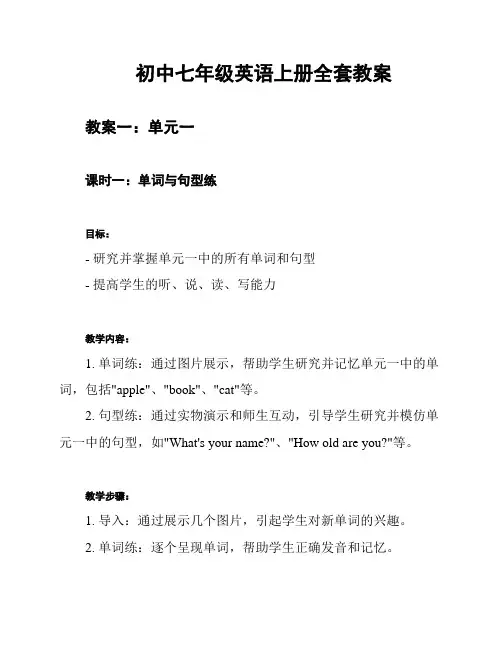
初中七年级英语上册全套教案教案一:单元一课时一:单词与句型练目标:- 研究并掌握单元一中的所有单词和句型- 提高学生的听、说、读、写能力教学内容:1. 单词练:通过图片展示,帮助学生研究并记忆单元一中的单词,包括"apple"、"book"、"cat"等。
2. 句型练:通过实物演示和师生互动,引导学生研究并模仿单元一中的句型,如"What's your name?"、"How old are you?"等。
教学步骤:1. 导入:通过展示几个图片,引起学生对新单词的兴趣。
2. 单词练:逐个呈现单词,帮助学生正确发音和记忆。
3. 句型练:教师通过实物演示提问学生,并引导学生用正确的句型回答。
4. 操练:进行小组活动,让学生之间互相进行问答练。
5. 总结:复所学的单词和句型,并进行小结。
教学评估:- 课堂练:通过课堂上的问答和互动,检查学生对单词和句型的掌握程度。
- 作业:布置写作练,让学生运用所学的句型写一段简短的自我介绍。
教案二:单元二课时一:阅读理解与写作练目标:- 提高学生的阅读理解能力- 培养学生的写作表达能力教学内容:1. 阅读理解:通过阅读一篇短文,让学生掌握文章的主要内容,并回答相关问题。
2. 写作练:通过给出一个话题,引导学生用正确的句型和词汇进行写作练。
教学步骤:1. 导入:用简单的问题引起学生对话题的兴趣。
2. 阅读理解:让学生阅读一篇短文,并回答与文章内容相关的问题。
3. 梳理文章结构:引导学生分析文章的结构和重点部分。
4. 写作练:给学生一个话题,让他们用所学的句型和词汇进行写作练。
5. 互评:学生之间互相交换作文并进行评价和修改。
教学评估:- 阅读理解考查:通过问题的回答检查学生对文章内容的理解程度。
- 写作评估:评价学生的写作表达能力、句式运用和词汇使用情况。
以上是初中七年级英语上册的教案一和教案二的概要内容,希望能对教学有所帮助!。

人教版7上英语教案5篇(实用版)编制人:__审核人:__审批人:__编制单位:__编制时间:__年__月__日序言下载提示:该文档是本店铺精心编制而成的,希望大家下载后,能够帮助大家解决实际问题。
文档下载后可定制修改,请根据实际需要进行调整和使用,谢谢!并且,本店铺为大家提供各种类型的实用资料,如工作计划、汇报材料、心得体会、发言稿、合同大全、申请书、演讲稿、作文大全、教案大全、其他资料等等,想了解不同资料格式和写法,敬请关注!Download tips: This document is carefully compiled by this editor.I hope that after you download it, it can help you solve practical problems. The document can be customized and modified after downloading, please adjust and use it according to actual needs, thank you!Moreover, our store provides various types of practical materials for everyone, such as work plans, presentation materials, reflections, speech drafts, contract summaries, application forms, speech drafts, essay summaries, lesson plans, and other materials. If you want to learn about different data formats and writing methods, please stay tuned!人教版7上英语教案5篇教案的实施需要教师具备良好的组织和管理能力,以确保教学过程的顺利进行,编写详细的教案可以帮助我们更好地运用各种教学方法和策略,提高教学的多样性,以下是本店铺精心为您推荐的人教版7上英语教案5篇,供大家参考。
人教版七年级上册英语教案16篇人教版七年级上册英语教案(精选篇1)一、复习指导思想新授课结束后,期末考试前,指导学生进行期末复习,主要复习基础知识,提高做题能力,训练阅读、听力与写作,使学生能够举一反三,熟练掌握知识点与考点.二、学生学习水平现状分析学生的主要问题是基础薄弱,做题能力参差不齐,优秀的学生不多,成绩有待于提高的学生比较多,一部分同学学习惰性强。
三、复习时间:十七周至十八周(共10课时)四、复习重点1、基础知识:unit1—unit8:重点词汇、短语、句型2、语法:(1)动词不定式(2)动名词(3)被动语态(4)形容词相关句型的运用(5)副词的运用(6)原因状语从句(7)过去进行时3、阅读训练(报纸阅读材料)4、听力(报纸、导学案套题听力训练)5、话题写作:肢体语言,义务工作,传统技艺,卡通漫画、动物保护、动物描写、未来生活畅想6、复习中注重讲练结合,及时反馈,及时检测五、课时安排时间为两周,具体计划如下:十七周(周一)unit1、2重点词组句型小结;语法训练(报纸2、3版)十七周(周二)unit1、2知识点练习,话题写作训练(报纸4版)十七周(周三)unit3、4重点词组句型小结;语法训练(报纸5、6版)十七周(周四)unit3、4知识点练习,话题写作训练(报纸7版)十七周(周五)unit5、6重点词组句型小结;语法训练(报纸8、9版)十八周(周一)unit5、6知识点练习,话题写作训练(报纸10版)十八周(周二)unit7、8重点词组句型小结;语法训练(报纸11、12版)十八周(周三) unit7、8知识点练习,话题写作训练(报纸13版)十八周(周四)模拟套题(报纸31版)(综合测试一)十八周(周五)模拟套题(报纸32版)(综合测试二)六、复习措施1、单词过关。
每天重点句子听写2、语法复习注重讲练结合,引导学生说出重点与易错点3、加强整理英语学习档案4、对于阅读训练有指导,有检测。
2024版七年级上册英语教案一、教学目标。
1. 语言知识目标。
- 学生能够掌握课本中的重点单词、短语和句型。
- 理解并能正确运用一般现在时、名词的单复数等语法知识。
2. 语言技能目标。
- 听:能听懂关于日常话题(如问候、介绍、学校生活等)的简单对话。
- 说:能够用英语进行简单的日常交流,如介绍自己、他人,描述事物等。
- 读:能读懂简单的英语短文,理解文章大意。
- 写:能够写出简单的句子,如介绍自己的基本信息、描述日常活动等。
3. 情感态度目标。
- 培养学生学习英语的兴趣,增强自信心。
- 引导学生了解不同文化背景下的英语使用习惯,培养跨文化交际意识。
二、教学重难点。
1. 教学重点。
- 重点单词和短语的记忆与运用,如“name, nice, to meet you, this, that”等。
- 一般现在时的用法,包括be动词(am/is/are)的正确使用。
- 简单的英语交际句型,如“ - What's your name? - My name is...”。
2. 教学难点。
- 一般现在时中第三人称单数动词的变化规则。
- 英语中名词单复数的特殊情况。
- 如何引导学生克服害羞心理,积极参与英语口语交流。
三、教学方法。
1. 情景教学法。
- 通过创设各种生活情景,如学校、家庭等,让学生在真实的语境中学习英语单词、短语和句型。
例如,在学习“classroom”这个单词时,可以展示教室的图片或者直接带学生到教室中,指着各种物品说英语单词。
2. 任务驱动法。
- 布置各种任务,如小组对话、角色扮演等,让学生在完成任务的过程中提高语言运用能力。
例如,给学生布置任务,让他们分组进行自我介绍的对话练习,然后在全班展示。
3. 游戏教学法。
- 利用游戏来激发学生的学习兴趣,如单词接龙、猜单词等游戏。
在游戏中,学生可以更加轻松愉快地学习和巩固知识。
四、教学过程。
(一)导入(5分钟)1. 播放一段简单的英语歌曲,如“Hello”,然后与学生互动。
人教版初一英语上册教案精选15篇教案可以帮助教师明确教学的目标和要求,指导教师在课堂上进行教学活动。
下面是小编为大家整理的人教版初一英语上册教案,如果大家喜欢可以分享给身边的朋友。
人教版初一英语上册教案【篇1】一、指导思想虽然大部分学生在小学已接触过英语,但学生以前不大重视英语,造成英语两极分化严重,且学习积极性低。
所以,现阶段最重要的是激发学生学习英语的兴趣和积极性,帮助他们增强信心,克服困难。
除了从思想上给予引导之外,在教学上,有针对性、目的性、有系统、有计划地上好课。
二、班级基本情况:本学期我担任七年级的英语课。
绝大多数学生虽然小学阶段都学过英语,但大部分学生的英语基础都比较差。
缺少学习的主动性和热情,自觉性也较差,相应的学习习惯也较差,对学习英语有为难情绪。
针对这些情况,在本学期的英语教学中,本人将致力于:一方面,应加强英语基础知识的讲解和基本技能的训练,让学生掌握词汇、语法、句型的基础知识和听、说、读、写等基本技能,为进一步学习英语打下坚实的基础;另一方面,又要采取多种措施,注意培养学生对英语学习的兴趣;让学生掌握记忆语音、单词、阅读和写作等英语学习技巧,培养良好的学习习惯和自主探索、合作探究能力,充分调动学生的学习积极性和主动性。
教学上采取任务型教学方式,运用灵活多变的方法,实现学生语言运用能力的迁移和拓展。
尊重并理解学生,与学生一起分享学习中的苦与乐,使每一位学生的英语成绩有所提高,有所进步。
三、七年级上册英语教学重、难点:(一)、语法知识点.1.一般疑问句及回答;2.指示代词、人称代词、物主代词3.名词复数的变化;4.方位介词;5.特殊疑问句的构成、回答和对划线部分提问6.实义动词的第三人称单数及变化;7、名词所有格;8、一般现在时9、时间表达法;(二)、交际用语。
四、七年级上册英语教学措施初一年级是英语学习的基础阶段,也是养成好习惯的关键时期。
基础打不好、习惯不良,直接影响学生整个初中阶段,乃至高中、大学的英语学习。
人教版初中七年级上册英语教案(完整版)一、教学内容Unit 1 你好Lesson 1 你好吗1. 教学目标:- 研究如何问候和回应问候的方式- 掌握与他人交流的基本问答方式- 学会用英语自我介绍2. 教学重点:- 掌握如何用英语问候和回应问候的方式- 学会在对话中使用一些常见的英语短语- 能够简单介绍自己的姓名、国籍和年龄3. 教学过程:- 导入新课,引导学生复英语问候语- 引入新的问候方式和回应,通过示范和练加深学生理解- 分组进行对话练,鼓励学生运用新学的问候方式与他人交流- 引导学生进行自我介绍,帮助他们掌握相关的英语表达4. 板书设计:- 问候语- Hello!- Hi!- How are you?- I'm fine, thank you.- 自我介绍- My name is [name].- I am from [country].- I am [age] years old.5. 作业要求:- 完成课堂练册上的相关练- 准备下节课的自我介绍Lesson 2 你是谁(以下内容略去不写)Unit 2 我的家(以下内容略去不写)二、教学目标在初中七年级上册英语教学中,我们旨在通过教授Unit 1和Unit 2的内容,帮助学生学会基本的英语问候和自我介绍方式,以及描述家庭成员和家庭的基本词汇。
通过各种实践活动和练,学生将能够在日常生活中简单地应用这些英语表达方式。
三、教学方法- 情景教学法:通过创设真实情景,引导学生使用所学知识进行对话练。
- 归纳法:通过提供示范和练,让学生总结语言规律和表达方式。
四、教学资源- 人教版初中英语教材《七年级上册》- 课件和多媒体设备- 课堂练册五、教学评估通过课堂练、对话练和个人介绍的方式,对学生对所学内容的掌握程度进行评估。
六、教学反馈及时反馈学生的研究情况,鼓励他们在研究过程中的积极表现,并针对学生的不足之处提出改进建议。
七、教学改进根据学生的研究情况和反馈意见,不断优化课堂教学过程,提高学生的研究效果。
2024年译林版七年级上册英语教案【】一、教学内容本节课选自2024年译林版七年级上册英语教材,具体包括Unit 1 This is me! 的Chapter 1和Chapter 2。
详细内容如下:1. Chapter 1: 熟悉并运用日常问候语,介绍自己及家人,学会表达喜好。
2. Chapter 2: 掌握一般现在时态,描述自己的日常活动和兴趣爱好。
二、教学目标1. 能够熟练运用日常问候语,进行自我介绍及介绍家人。
2. 学会表达个人喜好,增进同学间的了解。
3. 掌握一般现在时态,能描述自己的日常活动和兴趣爱好。
三、教学难点与重点1. 教学重点:一般现在时态的运用,自我介绍及描述日常活动。
2. 教学难点:一般现在时态的动词变化,如何描述兴趣爱好。
四、教具与学具准备1. 教具:多媒体设备、PPT、黑板、卡片。
2. 学具:课本、练习本、彩色笔。
五、教学过程1. 导入:通过播放一段英语歌曲,引导学生学习英语,激发学习兴趣。
2. 实践情景引入:设置不同的场景,让学生模拟实际交流,如学校、家庭等。
3. 例题讲解:讲解一般现在时态的用法,结合实例进行讲解。
4. 随堂练习:让学生运用所学知识进行自我介绍和描述日常活动。
5. 小组活动:分组讨论,互相介绍家庭成员和兴趣爱好。
六、板书设计1. This is me!2. 内容:Chapter 1: Greetings and selfintroductionChapter 2: Present Simple TenseExample sentences: I like playing football. He goesto school at 7:00 a.m.七、作业设计1. 作业题目:(1) Write a short selfintroduction, including your name, age, hobbies and family members.(2) Describe your daily routine using the Present Simple Tense.2. 答案:(1) My name is Tom. I am 12 years old. I like playing basketball and reading books. I have a brother and a sister.(2) I get up at 6:30 a.m. I have breakfast at 7:00 a.m. Then I go to school at 7:30 a.m. I have lunch at 12:00 p.m. After school, I play football with my friends. I do my homework at 7:00 p.m. and go to bed at 9:00 p.m.八、课后反思及拓展延伸1. 课后反思:关注学生在课堂上的表现,了解他们对知识的掌握程度,针对学生的反馈调整教学方法。
七年级上册英语教案(通用5篇)七年级上册英语教案(通用5篇)作为一名教师,常常需要准备教案,教案有利于教学水平的提高,有助于教研活动的开展。
怎样写教案才更能起到其作用呢?下面是小编帮大家整理的七年级上册英语教案(通用5篇),希望能够帮助到大家。
七年级上册英语教案1教材分析教材内容:新目标初中英语七上Unit1My name is Gina page 1-2教材处理:本单元的重点在于如何在一个新的场合下介绍自己和认识他人。
让刚入学不久的初中新生用英语搭建起他们友谊的桥梁。
学会用“What’s your name? / What’s her name? / What’s his name?”以及复习Starter U1-3 所学过的一些common English Greetings 来结识朋友。
本课生词量不大,重点在于对学生的口语操练以及常用人名的熟悉。
学情分析本单元的主题是熟识新伙伴,同时引导学生采用Practicing, Listening for specific information和Role playing的学习策略,学习一些新词汇,掌握一些重点句型,在小组合作学习的过程中,进一步促进学生之间的相互了解。
教学目标知识与能力采用Practicing, Listening for specific information和Role playing的学习策略,使学生学会打招呼和介绍自己、询问他人姓名的基本句型What’s your/his/her name?My/His/Her name is…。
”培养学生结交新朋友的能力。
过程与方法采用Practicing, Listening for specific information和Roleplaying的学习策略,利用教学图片或制作多媒体课件展开课堂Pair work; Group work的口语交际活动,询问他人姓名、查询电话号码,了解有关姓名的文化知识并制作个性名片。